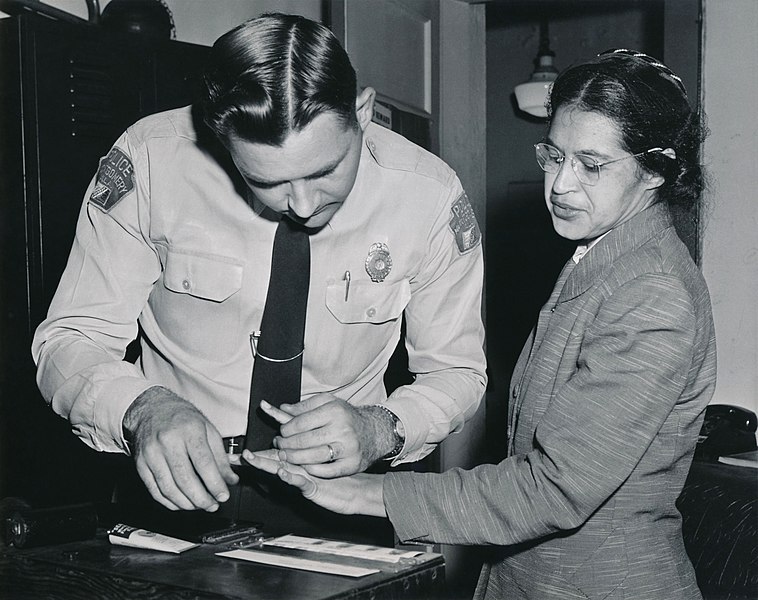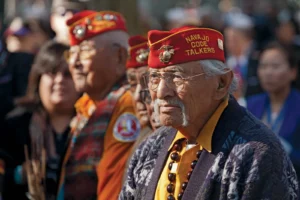
Rosa Parks: The Making of a Civil Rights Legend
Protesting a Segregated System
There were others before her. She was not the first African American woman who refused to surrender her seat on a city bus so a white person could sit down. She was not even the first black female in Montgomery, Alabama, to take a stand against the city’s Jim Crow laws and customs that year. Four other women in Rosa Parks’ hometown were arrested in 1955 under similar circumstances. They sued the city, and their case was working its way through the federal courts when Parks was arrested on December 1, 1955.
Montgomery’s black citizens were frustrated with a city ordinance requiring them to sit in a designated “colored section” at the back of the bus. White bus drivers enforced other onerous policies not required by the law. If the “colored section” was full when white passengers boarded the bus, the drivers expected black passengers to surrender their seats and stand so the white people could sit. Rosa Parks refused to give up her seat in the “colored section” and was arrested for disorderly conduct.
These arrests were not a new phenomenon in the south. Other African Americans, with names now familiar to many, were arrested after refusing to surrender their bus seats while traveling in the South. Bayard Rustin was arrested in Tennessee in 1941, and 2nd Lt Jack Roosevelt Robinson was court-martialed after his arrest in Texas in 1943. Rustin became an influential civil rights activist, and Robinson won fame as the first African American to play in baseball’s previously all-white major leagues.

Who Was Rosa Parks?
Like Rustin, Rosa Parks was active in the civil rights struggle before her arrest and remained active for decades after. Still, she is best known for that moment on a city bus in Montgomery, Alabama, when she demanded courtesy and respect from a system resistant to giving them.
Over the years, that moment became a myth. Many elementary children learned – are perhaps still learning – that Rosa was tired after working a long day as a seamstress for a local department store. She did not want to give up her seat because she needed the rest. In her autobiography, Rosa disputes this version. She was not physically tired but “tired of giving in.” She was not going to give in again. She would find out that day, she later told a radio interviewer, “for once and for all what rights I had as a human being and a citizen” (Rosa Parks’ account of her arrest begins at the 3:56 mark).
Why Rosa Parks? Why did she become the face of the Montgomery Bus Boycott movement that followed her courageous stance and ultimately ended legal bus segregation in the United States? One reason was her experience in the long African American struggle for full civil and political rights. Parks and her husband Raymond were active in the Montgomery chapter of the NAACP for over two decades before her arrest. In her work with the NAACP, Parks championed the cause of the Scottsboro Boys, a group of young African American men falsely accused of raping a white woman. She campaigned for a fair hearing for two black Montgomery women, Recy Taylor and Gertrude Perkins, who had accused white men of raping them. Parks registered to vote in 1945, which was nearly impossible for a black woman to accomplish at the time. She briefly worked for white liberal activists Clifford and Virginia Durr, who encouraged her to attend the Highlander Folk School, a school that developed civil rights leaders. There, she was mentored by another civil rights activist, Septima Clark. She was briefly employed at Maxwell Air Force Base, where she rode integrated trolleys. There she learned what others considered impossible – blacks and whites could sit together peacefully on city buses.

The Montgomery Bus Boycott
E.D. Nixon, the president of the NAACP’s Montgomery chapter, considered her arrest a “gift” to the movement. Rosa Parks was married, employed, enjoyed a reputation for good character, and, most notably to Nixon, was quiet, mature, and dignified. When they were arrested, two of the women arrested earlier in 1955 and now suing the city were only 15 years old. Nixon considered Rosa’s age and quiet dignity necessary for someone to be the face of the organization’s efforts to desegregate Montgomery. She was, Nixon recalled, “one of the finest citizens of Montgomery – not one of the finest Negro citizens, but one of the finest citizens of Montgomery.”
Nixon mimeographed 35,000 flyers calling for a one-day boycott of the city buses the night of Parks’ arrest. The boycott would coincide with the day of her trial. That effort was so successful that Nixon and Rev Ralph Abernathy, a minister in Montgomery, decided to extend the boycott. They organized the “Montgomery Improvement Association” and solicited Martin Luther King, Jr., the charismatic young preacher at Dexter Avenue Baptist Church, to lead the effort. The MIA made three demands the city must meet before blacks – 70 % of the bus ridership – would return to the buses. They insisted that all riders receive courteous treatment, that the bus company begin hiring black drivers, and that all seating on the city buses be available on a first come–first serve basis.
The Montgomery Bus Boycott began four days after Rosa Parks’ arrest, December 5, 1955. Boycott leaders organized carpools, black taxi drivers charged riders the same fare the buses charged, and Montgomery’s black citizens walked to work or school to sustain the boycott. Meanwhile, the NAACP pursued legal redress. They chose not to make Rosa Parks a plaintiff in their lawsuit. They feared doing so might delay a case already in federal court. Instead, the four women previously arrested in 1955, Claudette Colvin, Aurelia Browder, Irene Morgan, and Lillie Mae Bradford, continued as plaintiffs in a case called Browder vs. Gayle. In November 1956, the Supreme Court ruled that segregation on city buses was unconstitutional because it violated the equal protection clause of the 14th Amendment. The order to desegregate reached Montgomery on December 20, 1956, and the boycott ended the next day when riders returned to the buses on a non-segregation basis.
Rosa Parks suffered for her civil rights stance. She and her husband lost their jobs and received death threats. Raymond and Rosa moved to Hampton, VA before settling in Detroit where Parks continued her battle against racial discrimination. In Detroit, she focused on the city’s unfair housing practices and other inequalities. She died in 2005 and became the first African American woman to “lay in honor” in the U.S. Capitol Rotunda in Washington.

Ray Tyler was the 2014 James Madison Fellow for South Carolina and a 2016 graduate of Ashland University’s Masters in American History and Government. Ray is a former Teacher Program Manager for TAH and a frequent contributor to our blog.



